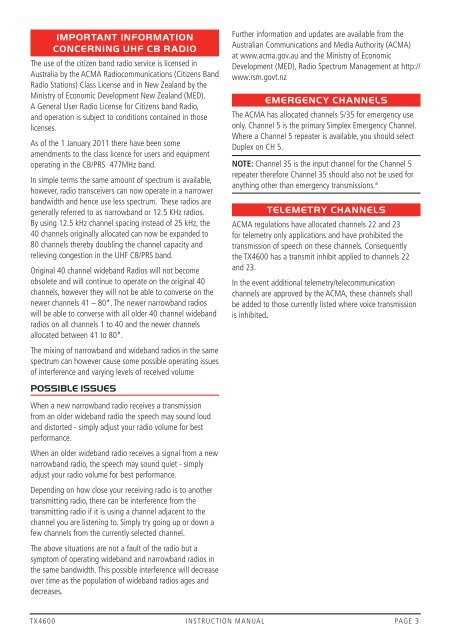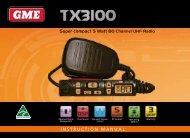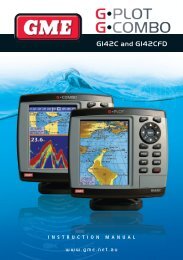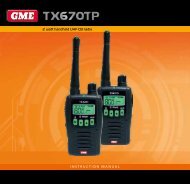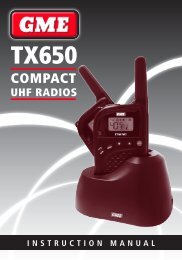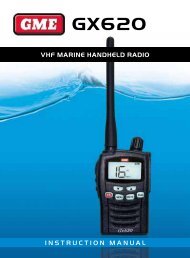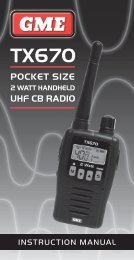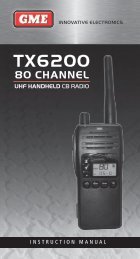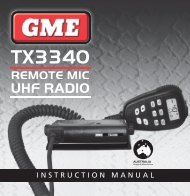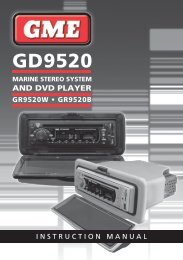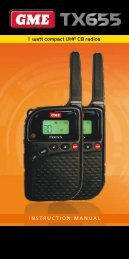TX4600 - GME
TX4600 - GME
TX4600 - GME
You also want an ePaper? Increase the reach of your titles
YUMPU automatically turns print PDFs into web optimized ePapers that Google loves.
IMPORTANT INFORMATIONCONCERNING UHF CB RADIOThe use of the citizen band radio service is licensed inAustralia by the ACMA Radiocommunications (Citizens BandRadio Stations) Class License and in New Zealand by theMinistry of Economic Development New Zealand (MED).A General User Radio License for Citizens band Radio,and operation is subject to conditions contained in thoselicenses.As of the 1 January 2011 there have been someamendments to the class licence for users and equipmentoperating in the CB/PRS 477MHz band.In simple terms the same amount of spectrum is available,however, radio transceivers can now operate in a narrowerbandwidth and hence use less spectrum. These radios aregenerally referred to as narrowband or 12.5 kHz radios.By using 12.5 kHz channel spacing instead of 25 kHz, the40 channels originally allocated can now be expanded to80 channels thereby doubling the channel capacity andrelieving congestion in the UHf CB/PRS band.Original 40 channel wideband Radios will not becomeobsolete and will continue to operate on the original 40channels, however they will not be able to converse on thenewer channels 41 – 80*. The newer narrowband radioswill be able to converse with all older 40 channel widebandradios on all channels 1 to 40 and the newer channelsallocated between 41 to 80*.The mixing of narrowband and wideband radios in the samespectrum can however cause some possible operating issuesof interference and varying levels of received volumePOSSIBLE ISSUESWhen a new narrowband radio receives a transmissionfrom an older wideband radio the speech may sound loudand distorted - simply adjust your radio volume for bestperformance.When an older wideband radio receives a signal from a newnarrowband radio, the speech may sound quiet - simplyadjust your radio volume for best performance.Depending on how close your receiving radio is to anothertransmitting radio, there can be interference from thetransmitting radio if it is using a channel adjacent to thechannel you are listening to. Simply try going up or down afew channels from the currently selected channel.The above situations are not a fault of the radio but asymptom of operating wideband and narrowband radios inthe same bandwidth. This possible interference will decreaseover time as the population of wideband radios ages anddecreases.further information and updates are available from theAustralian Communications and Media Authority (ACMA)at www.acma.gov.au and the Ministry of EconomicDevelopment (MED), Radio Spectrum Management at http://www.rsm.govt.nzEMERGENCY CHANNELSThe ACMA has allocated channels 5/35 for emergency useonly. Channel 5 is the primary Simplex Emergency Channel.Where a Channel 5 repeater is available, you should selectDuplex on CH 5.NoTe: Channel 35 is the input channel for the Channel 5repeater therefore Channel 35 should also not be used foranything other than emergency transmissions.ªTELEMETRY CHANNELSACMA regulations have allocated channels 22 and 23for telemetry only applications and have prohibited thetransmission of speech on these channels. Consequentlythe <strong>TX4600</strong> has a transmit inhibit applied to channels 22and 23.In the event additional telemetry/telecommunicationchannels are approved by the ACMA, these channels shallbe added to those currently listed where voice transmissionis inhibited. F<strong>TX4600</strong> INSTRUCTION MANUAL PAGE 3


